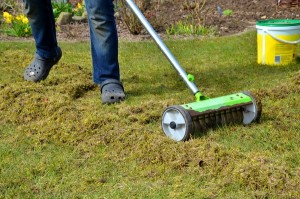FAQ: How Often Should I Fertilize Bermuda Grass?
Tuesday, June 18th, 2019A question we get asked frequently around here is…
“How often should I fertilize Bermuda grass?”

It’s a great question and knowing the answer will help ensure that you have the healthiest lawn possible; one that thrives through the warm months of the year.
So here is your answer:
You should fertilize your Bermuda grass about once a month in the spring using a quick-release, complete fertilizer Once your lawn is fully green and dense, you can switch to a slow-release fertilizer. This will slow the growth of your lawn, so it doesn’t become overgrown.
It’s important to switch to a slow-release fertilizer once your lawn is dense, so that you won’t get a lot of growth. This ensures you’re caring for your lawn in the most efficient manner.
We have several other articles related to the topic of Bermuda grass, including midiron, and fertilizer on our site. Here’s a round-up of those articles, in case you’re still curious or have some other questions.
Other Helpful Articles
How To Get Rid of Weeds – This article describes the most common weeds in Arizona and how to eliminate them from your lawn.
Effects of Over-fertilizing – This article explains how you can accidentally over-fertilize your lawn. It also tells you how to repair an over fertilized lawn.
Can I Fertilize My Lawn in the Summer – This article answers that question and gives additional fertilization tips.
Best Fertilizer for Bermuda Grass – This article goes into detail on which fertilizer is best to use on your Bermuda sod, depending on the time of year and the maturity stage of your lawn.
Common Lawncare Mistakes and How to Avoid Them – This article helps you avoid the most common lawn care mistakes that homeowners make.
Best Time of Year to Aerate Your Bermuda Grass Lawn – This article explains the process of aerating your lawn, why it is important, and when is the best time of year to do so.
About Evergreen Turf
Here at Evergreen Turf, we pride ourselves on being your go-to source for sod in Arizona. Whether you just need tips on how to keep your lawn healthy year-round or you need to purchase sod from us, we have you covered. We even offer installation of our sod products, so you don’t have to worry about installing it yourself.
Not sure which type of sod is right for your lawn? Take our quiz to help you select which variety of sod is suited for your unique conditions. For all things related to lawn care, be sure to check out our lawn care section on our website, which covers everything from irrigation and mowing to nutrition, insect control and fall over-seeding.
If you have any other questions about Arizona sod, whether it has to do with fertilizing your Bermuda sod or anything else, contact our team today and let us know how we can help you. You can also ask us questions or just say hi on our Facebook page!

